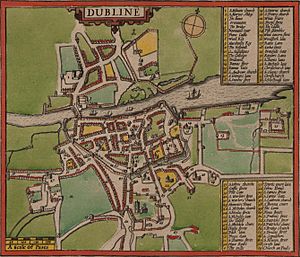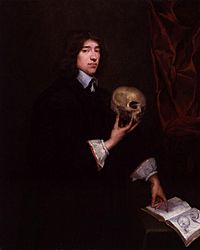St. Bride's Church, Dublin facts for kids
Quick facts for kids St Bride's Church |
|
|---|---|
 |
|
| Lua error in Module:Location_map at line 420: attempt to index field 'wikibase' (a nil value). | |
| Location | Corner of Bride Street and Bride Road, Dublin |
| Country | Ireland |
| Denomination | Church of Ireland |
| Previous denomination | Church of Ireland |
| History | |
| Founded | c. 800 |
| Architecture | |
| Style | Gothic/Romanesque |
| Completed | 1684 (final iteration) |
| Closed | 1898 |
| Demolished | 1898 |
| Administration | |
| Diocese | Diocese of Dublin and Glendalough |
| Province | Dublin |
St. Bride's Church was a Church of Ireland church. It was located in Dublin, Ireland, at the corner of Bride Street and Bride Road.
The church was closed in 1898. It was then taken down to make space for new homes. These homes were built by the Iveagh Trust and are now called the Iveagh Trust Buildings.
Contents
History of St. Bride's Church
The first St. Bride's church was a very old Irish church. It was built before the Vikings arrived in Ireland, around the year 800. It was named after St. Bridget. This church was located just south of Dublin's old city walls. It was also north-east of where St. Patrick's Cathedral stands today.
In 1178, St. Laurence O'Toole gave the church's income to the Priory of the Holy Trinity. This priory is now known as Christ Church Cathedral. Later, the income was moved to help fund St. Patrick's Cathedral. Not much else happened with the church until the time of the English Reformation.
Rebuilding the Church in 1684
The church, which was then part of the Church of Ireland, was rebuilt in 1684. This work was led by Nathaniel Foy. He was the rector, or main priest, of St. Bride's. Nathaniel Foy was born in York but grew up in Dublin.
Before this rebuilding, the parishes of St. Bride, St. Stephen, and St. Michael Le Pole had joined together. This led to the older churches of St. Stephen and St. Michael Le Pole no longer being used.
Changes in 1860
In 1860, the church had many big changes made to it. These changes were done by Welland and Gillespie. They followed plans from the architects of the Ecclesiastical Commissioners.
The updates included new windows and a new pulpit. They also added a reader's desk and new tiled floors. The church's bell tower was changed, and a new bell was put in.
Closing and Demolition
St. Bride's Church closed its doors in 1898. However, its beautiful organ case can still be seen today. It is kept at the National Museum of Ireland.
The church was taken down to build homes for people who needed them. This housing project was for the poor. It was called the Iveagh Trust and was paid for by Edward Guinness, 1st Earl of Iveagh. These buildings still stand in the same spot today.
The Churchyard
Many people who lived in the area were buried in the churchyard. When the land was developed around 1900, some of their remains were moved. They were taken to Mount Jerome Cemetery.
Thomas Carter was a politician. He was also the Master of the Rolls in Ireland. He was buried in the churchyard in 1763.
O'Hanlon, who worked at the Record Tower in Dublin Castle, is also buried here. He was killed in 1803 during a rebellion led by Robert Emmet.
The kind developer and helper Thomas Pleasants (1729–1818) was buried in the churchyard. His wife, Mildred Daunt, was also buried there. Pleasants Street was named after him. Thomas Pleasants gave a lot of money to help others. For example, he gave over £12,000 in 1814. This money was for a large building near Cork Street for poor weavers. He also gave £8,000 to build the Meath Hospital. He even gave his own house on Camden Street. This house became a school and orphanage for Protestant girls. He also provided money for the school to run and for small gifts for the girls.
The Parish of St. Bride's
A parish is like a local church district. The parish of St. Bride's was also known as St. Bridget's. It was made up of three smaller parishes. These were the old St. Bride's, St. Stephen's (from the 1200s), and St. Michael de la Pole. St. Michael de la Pole was also an old Irish settlement from before the Norse people arrived.
In 1707, parts of this parish were used to create a new parish. This new parish was called St. Anne. Parts of St. Peter and St. Kevin parishes were also used.
The St. Bride's parish stretched along Bride Street. It went as far as Ship Street and Golden Lane. It also went east to George's Street and Stephen Street. The area of the parish matched the civil parish of St. Bridget. In 1766, the government asked Protestant church leaders to count how many people lived in each parish. This count showed that St. Bride's parish had 430 Catholic families and 84 Protestant families.
At first, the parish had some wealthy people living there. This was because many government workers lived nearby. Also, it was close to Dublin Castle, where important decisions were made. But during the 1700s, many people in the Liberties area faced money problems. By the 1800s, this parish became one of the poorest in Dublin. It had many crowded, unhealthy homes called tenements.
In 1813, the parish had 4,367 males and 5,272 females. Only a small number of these people belonged to the Church of Ireland. The number of people kept growing. This was especially true during and after the Great Famine. Many poor people from the countryside moved to Dublin looking for work and places to stay.
In 1863, during a difficult economic time, Father Spratt helped the poor. He was a Carmelite priest from nearby Whitefriar Street Church. He went from house to house across the city. He collected money for the 6,000 very poor people in the parish. The rector of St. Bride's at that time was Rev. William Carroll. He also spent a lot of time helping the poor, both Catholic and Protestant. Catholics in the area even called him "Father" Carroll.
In 1901, the parish had 6,155 people. By 1971, many old houses had been taken down. The population then dropped to 1,335 people.
People Connected to St. Bride's
Sir William Petty (1623–1687) was an important member of the parish. He owned a pew and a burial vault in the church. He lived in Exchequer Street and later on St. Stephen's Green. The Shelbourne Hotel stands there now.
Sir Edward Bolton, a chief judge in Ireland, was buried here in 1659.
The famous writer and politician Sir Richard Steele was christened, or baptized, at St. Bride's parish Church on March 12, 1672.
Arthur Keene (died 1818) was an important member of the Methodist community in Dublin. He married his wife Isabella in this church in April 1775. The wedding was performed by John Wesley himself.
Many members of the Lloyd family from New Ross were connected to this church. Two of them, Bartholomew Lloyd (1772–1837) and his son Humphrey Lloyd, were leaders at Trinity College Dublin. Many Lloyds were baptized, married, or buried here. These included Dr. Thomas Lloyd and Alderman Edward Lloyd, who was a Lord Mayor.
The Rev. Peter Le Fanu (1749–1825) was a relative of Joseph Sheridan Le Fanu. He became a curate, or assistant priest, in this parish in the 1770s. He was known as one of Dublin's most popular preachers. He also wrote plays.
Several members of the Domville family were part of the parish. Sir William Domville was a very important member. He was the father-in-law of William Molyneux. For many years, he was the chief lawyer for Ireland. He wrote a book about whether laws made in England should apply to Ireland without Ireland's agreement. This book influenced Molyneux. William's father, Gilbert Domville (1565–1624), came to Ireland from Cheshire during the time of King James I.
A highly respected rector of St. Bride's in the late 1800s was the Rev. William George Carroll (1821–1885). He was a historian and writer. He was also the uncle of George Bernard Shaw. He was the first Protestant church leader in Ireland to support Home Rule. This meant he believed Ireland should govern itself. He gathered a lot of information about his church and parish. He found many valuable old records going back to 1633. This collection is considered one of the most important church collections in Ireland.



